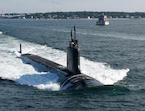SeaQueen
Posts: 1451
Joined: 4/14/2007
From: Washington D.C.
Status: offline

|
Damage modeling is always a sketchy business. There are people at the Naval Undersea Warfare Center (NUWC) who spend their careers obsessing over it. I'm sure some people there could show you things that would amaze you.
For submarines, at the right depth, if the right pipe breaks in a submarine it might very easily sink to to the bottom and the hull might never be breached. The deep diving Alfa, theoretically, was more resistant to pressure, and might, particularly at shallower depths, be more resistant to certain types of damage (e.g. overpressure). There are other mechanisms by which a warhead might damage a submarine, though. Just the shock of an explosion transmitted through the hull can break pipes, causing it to sink without the hull being damaged at all. Command doesn't take all that into account. The damage model is an abstraction. It's the "good enough" solution, not necessarily the perfect solution. After ADCAP, the program to update the Mk48, I suspect that any theoretical advantages that the Alfa had on older Mk 48s were nullified. Hooray for spiral development!
As far as the agility modifiers, once again, they're intended to be approximate. An extra degree of freedom on the engine nozzles probably doesn't provide a decisive advantage for the PAK-FA vs. an F-22, particularly in the domain of combat that Command really captures best.
quote:
ORIGINAL: Brisbin
I just got the game and I am having fun with it. My question is shouldn't the Russian Titanium subs have higher hull strength? I mean if they can dive deeper wouldn't it mean that they could take more damage. The Harpoon games had the same problem. Also, how come the F22 and the Pak FA have the same agility as the Pak FA can move its exhaust in more directions than the up down movement of the F22?
< Message edited by SeaQueen -- 3/30/2017 5:09:41 PM >
|
 Printable Version
Printable Version








 New Messages
New Messages No New Messages
No New Messages Hot Topic w/ New Messages
Hot Topic w/ New Messages Hot Topic w/o New Messages
Hot Topic w/o New Messages Locked w/ New Messages
Locked w/ New Messages Locked w/o New Messages
Locked w/o New Messages Post New Thread
Post New Thread